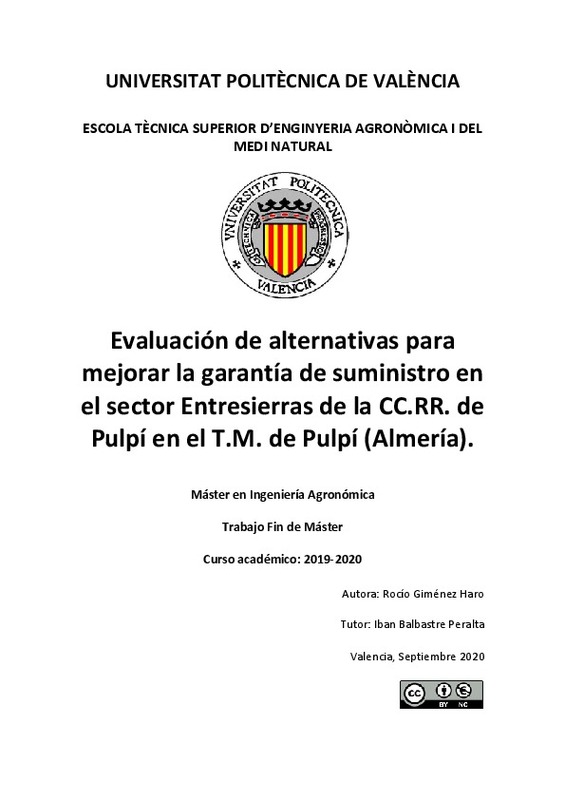|
Resumen:
|
[ES] La Comunidad de Regantes de Pulpí consta de 8.380 hectáreas de riego, dedicadas al cultivo de gran variedad de frutas y hortalizas. Durante los últimos años, ha tenido que lidiar con períodos de sequía debido a la ...[+]
[ES] La Comunidad de Regantes de Pulpí consta de 8.380 hectáreas de riego, dedicadas al cultivo de gran variedad de frutas y hortalizas. Durante los últimos años, ha tenido que lidiar con períodos de sequía debido a la escasez de precipitaciones en la zona y a la falta de infraestructuras con las que garantizar el suministro del recurso hídrico.
Como consecuencia de ello, se han tenido que implementar medidas restrictivas del uso del agua, lo que conlleva a una reducción de rendimientos en los cultivos y de su calidad.
Ante esta problemática, en este Trabajo Fin de Máster, se van a evaluar diferentes alternativas para mejorar la garantía de suministro de agua a los regantes mediante tres ámbitos de actuación: alternativas en la entrada de suministro (maximizar las fuentes), alternativas en la demanda del recurso (reducir el consumo) y, por último, mejorar la gestión de suministro interna de la Comunidad de Regantes de Pulpí.
Para su realización se parte de los datos facilitados por la CC.RR., así como de cartografía y archivos pertenecientes a las entradas de agua.
En la primera etapa, se estudiarán las fuentes de esta Comunidad, se realizará una caracterización de los cultivos pertenecientes al sector Entresierras y se evaluarán las salidas de recurso hídrico. Una vez recogida esta información, se procederá al análisis del déficit que se produce entre aportes recibidos y demanda de los cultivos y se evaluarán las alternativas a tratar. En el primer grupo de alternativas se estudiarán las fuentes de aporte, en el segundo grupo se propondrán técnicas de cultivo para obtener un ahorro de agua y la sustitución de un porcentaje de cultivos que requieren más aporte hídrico por otros que requieran un menor aporte y en el tercer grupo de alternativas se analizará cómo paliar las diferencias entre entradas y salidas del volumen de agua y se dimensionará un nuevo embalse para ampliar su capacidad.
Todas estas alternativas se cuantificarán para ofrecer un coste aproximado de cada una de ellas a la CC.RR de Pulpí.
[-]
[EN] The Pulpí Irrigation Community consists of 8.380 hectares of irrigated land, dedicated to the cultivation of a wide variety of fruits and vegetables. In recent years, it has had to deal with periods of drought due to ...[+]
[EN] The Pulpí Irrigation Community consists of 8.380 hectares of irrigated land, dedicated to the cultivation of a wide variety of fruits and vegetables. In recent years, it has had to deal with periods of drought due to the scarcity of rainfall in the area and the lack of infrastructure with which to guarantee the supply of water resources.
As a result, measures restricting water use have had to be implemented, leading to a reduction in crop yields and quality.
In view of this problem, in this Master¿s Thesis, different alternatives will be evaluated to improve the guarantee of water supply to irrigators through three areas of action: alternatives in the supply input (maximising sources), alternatives in the demand for the resource (reducing consumption) and finally, improving the internal supply management of the Pulpí Irrigation Community.
The project is based on data provided by the Community, as well as on maps and files belonging to the water supply.
In the first stage, the sources of this Community will be studied, a characterization of the crops belonging to the Entresierras sector will be carried out and the outlets of water resources will be evaluated. Once this information has been collected, the deficit between the inputs received and the demand for the crops will be analysed and the alternatives to be treated will be evaluated. In the first group of alternatives, the sources of supply will be studied, in the second group, cultivation techniques will be proposed to obtain water savings and the replacement of a percentage of crops that require more water supply by others that require less, and in the third group of alternatives, how to alleviate the differences between water volume inputs and outputs will be analyzed and a new reservoir will be sized to increase its capacity.
All these alternatives will be quantified to provide an approximate cost of each one of them to Irrigation Community.
[-]
|




![PDF file [Pdf]](/themes/UPV/images/pdf.png)



